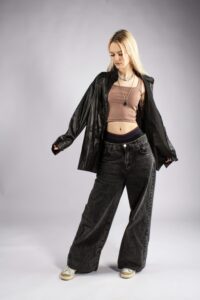Anti-fashion trend of the 2000s is an extremely revolutionary departure from the norms of regular fashion. This style surfaced as a response against a stylish and totally polished look that defined the style of the 1990s. It represents individualism, comfort, and a way of defiance against the generally acceptable styles.
During these intervening years, women’s fashions would wear this blog post on anti-fashion styles. Looking into what sparked the anti-fashion movement and further exploration to solidify the broad concept of anti-fashion itself.

What Was the Anti-Fashion Movement?
It was because of over commercialism and homogenization that the anti-fashion movement took place. Consumers became jaded by the time late 1990s and early 2000s with perfection taken through high fashion brands.
This brought about something more practical that they could associate with rather than the perfect for everything. Anti-fashion styles of the 2000s brought expressions for the personal identities rather than emulating the trends established by the commercial sector.
Characteristics of the Anti-Fashion Period
Comfort Over Everything: Comfort was placed on top, and thus oversized clothing, baggy jeans, and loose-fitting shapes became truly favoured.
Thrift Store Fashion: The discovery of vintage shopping and thrift finds is what defined the style. This eventually included and inspired people to experiment and integrate different styles into their own.
DIY Spirit: Hailing from the do-it-yourself approach that sprouted during this period, people begin tailoring and accessorizing clothing and accessories with patches, pins, or even different individual alterations that would differentiate a piece.
The Key Anti-Fashion Trends of the 2000s
1.Grunge Revival
Early 2000’s grunge revival was just a faint whisper of the subculture from the 90’s. It was about flannel shirts and combat boots, together with ripped-up jeans. Females wore the unkempt look against the traditional ideals of femininity. High heels and skirts dominated wardrobes for comfort.
Normcore
An antidote to the trendiness of fashion, normcore was all about the celebration of the mundane. It was an everyday, often oversized clothing that looked deliberately unfashionable. Dad sneakers, plain t-shirts, and basic jeans-remember skinny scrubs. That’s the fashion of anti-fashion trends in the gear women wear, where authenticity wins over image.
-
Logo Mania
While some might argue that logos symbolize brand loyalty, during the 2000s, oversized logos were seen as an anti-fashion statement. The wearer of streetwear with emblazoned large logos was then against fashion and was speaking out against the egocentricity of the fashion industry with regard to status and identification within the brand.
This type of streetwear offered the possibilities of feminine expressions of individuality but also embraced commentary on consumer culture.
-
Streetwear Influence
Streetwear became the style in 2000, where urban and haute couture blended into a cultural phenomenon. This line of trend now focuses on anti-fashion to redefine the status standards-broken tradition by giving women the freedom to wear their sneakers, hoodies, and oversized outerwear with their everyday wardrobe.
Role of Social Media
The new medium for anti-fashion was created in the form of social media, so it is only logical to deduce that the birth of social media gave an opportunity for yet another medium for anti-fashion. Blogs and its equivalent, such as Instagram, meant that people have an outlet for expressing their individual styles and freedom from other dominant narratives that have kept old-age fashion on a pedestal. End
This decade should not have the lead cause of the current stylings of women’s anti-fashion clothing being seen as the presence of subcultures. Punk, goth, hip-hop, and so many others only fed the use in clothes of people based on their principles and practices in life. Women were eclectic and powerful in looks as they borrowed elements from a number of different subcultures.
The Consequences of Anti-Fashion Trends
These movements of the 2000s anti-fashion truly held tight in place within the bounds of history. The designers learned how to add comfort and reality into the design. The untucked silhouettes took over the runway, and at least there began to be some options for more inclusive sizing that appear to reflect consumer wants as well as their desperate need for relatability, not impossible ideals.
Sustainable and Ethical Fashion
As such, anti-fashion can therefore be said to have given breeding grounds to the seemingly rampant promotion of sustainability and ethics in the world of fashion. While individualism has long been valued in the world of fashion, it was only until recent times that the pursuit of value in that particular context came to be mandatorily related to considering the environmental and social connotations of clothes worn.
Thrifting, upcycling, or making indie brands chic went side by side with the principles of anti-fashion ideology, that is authenticity and self-expression.
Conclusion
The anti-fashion trends of the 2000s represented a pivotal moment in the evolution of style. The anti-fashion movement was also put to a very good use as it challenged the culture that had established itself through individuality, thus changing the present face of fashion.
To this point, constituents of anti-fashion are already penetrating the present fashion market because they are comfortable, environment-friendly, and self-expression. This modern generation harbours the anti-fashion spirit, which is a reminder of a celebration of uniqueness in identity through clothing choices.


